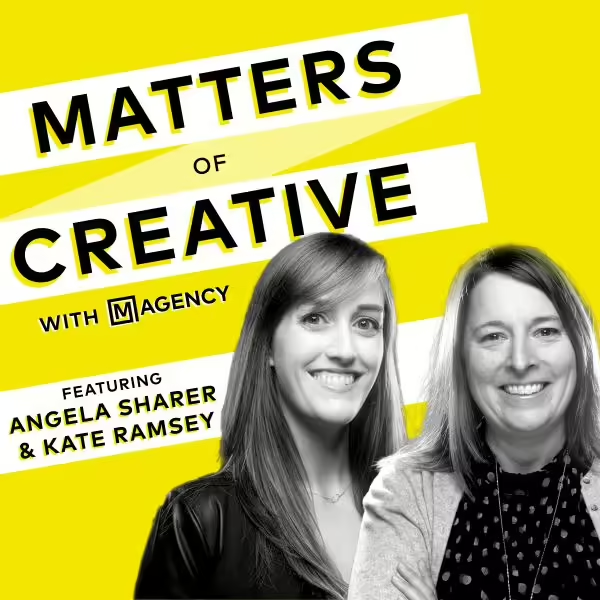IN THIS EPISODE…
In recent decades, the advent of DTC and other instant online services have shifted consumer expectations, forcing brands to pivot to reimagine the user experience. Design thinking has emerged as a cornerstone for innovation and out-of-the-box value-creation methods. How can brands leverage this creative technique to enhance the customer experience?
In today’s episode of Matters of Creative, Matt Hirsch welcomes Kate Ramsey and Angela Sharer of Nordstrom to discuss UX design and research strategies. Together, they explain how UX design can adapt to incorporate new technology, the role of research in the Double Diamond framework, and how they collaborate on UX design projects together.
Design thinking requires a creative professional to evaluate, sketch, and communicate their ideas for catering to the end user. As master researchers and designers in this space, Kate Ramsey and Angela Sharer employ the Double Diamond framework to identify the customer problem and develop value-added solutions. This in-depth planning cycle involves leveraging divergent thinking to generate ideas, convergent thinking to narrow down the ideas, and lateral thinking to influence your perception of the consumer’s problem. Angela also implements observational research and data insights to refine the framework and identify a final solution.
Listen today for more ways you can use design thinking in your UX strategies.
ABOUT OUR GUEST:

Kate Ramsey is the Senior Principal of UX Design and Experience Strategy at Nordstrom, where she aligns teams to create cohesive and meaningful customer experiences across multiple channels. She has been with the company since 2011, holding roles including UX Design Manager and Principal UX Designer. Having studied fine art and graphic design, Kate transitioned into new media by teaching herself how to design digital interfaces for a CD company.

Angela Sharer is the Principal UX Researcher at Nordstrom, where she focuses on customer-facing experiences on the website and mobile app. As a user experience researcher, she has over 10 years of experience impacting consumer and B2B products and services. After obtaining a master’s degree in human-centered design and engineering, Angela manufactured Android smartphones, wearables, and virtual reality headsets at HTC.
Learn more about Kate & Angela:
https://www.linkedin.com/in/kate-ramsey-she-her-016766/
https://www.linkedin.com/in/angelasharer/
Here’s a Glimpse of what you’ll learn:
- [2:28] Kate Ramsey and Angela Sharer’s background in UX design and how they began working at Nordstrom
- [7:03] How Kate and Angela collaborate on UX design projects at Nordstrom
- [12:05] What is design thinking, and why should businesses leverage it?
- [18:23] Kate breaks down the Double Diamond framework
- [23:52] The difference between divergent, convergent, and lateral thinking
- [29:23] Research’s role in the Double Diamond framework
- [32:43] Angela describes the various UX research methodologies
- [37:12] Best practices for implementing the Double Diamond framework
- [41:52] Measuring the Double Diamond framework’s success
- [44:23] How AI will impact UX design and other forthcoming trends in the space
RESOURCES MENTIONED IN THIS EPISODE:
Quotable Moments:
- “The nature of our work, as with any creative profession, is that initial ideas fail as part of the expected process.” – Kate Ramsey
- “Each project team at Nordstrom has its success metrics… it’s pretty clear to see, did that happen or not.” – Angela Sharer
- “The happiest I am is when I see a team that’s not typically accustomed to using our processes reach out for tips.” – Kate Ramsey
- “AI could generate a decent summary that you could send out to stakeholders to give them a status update.” – Angela Sharer
- “With new technology and interfaces like AI, it’s quite possible that our traditional methods may need to adapt.” – Kate Ramsey
Action Steps:
- Set up Google alerts for UX and AI trends: This helps businesses stay updated on industry shifts and new tools that may impact user experience design and research practices.
- Engage with professional communities on LinkedIn and participate in local UX events: Networking with peers fosters knowledge exchange and keeps you abreast of the evolving best practices in the UX field.
- Implement design thinking incrementally within organizations: This gradual integration allows you to assess its effectiveness and make improvements without overwhelming teams.
- Conduct regular observational research and usability testing: These methods reinforce user-centric approaches, ensuring your designs meet the actual needs and behaviors of users.
- Embrace failure as part of the creative process: Recognizing that not every idea will be successful helps maintain a culture of innovation and continuous improvement.
SPONSOR FOR THIS EPISODE…
This episode is brought to you by M Agency, a full-service creative marketing agency in Tacoma, Washington.
We are a strategic partner for companies wanting to build memorable brands, websites, and marketing campaigns.
Our team of creative professionals leverages their unique talents and skills to provide various branding, design and development, marketing, and creative services.
If you’re ready to take action with your marketing, visit https://whatisyourm.com/.



